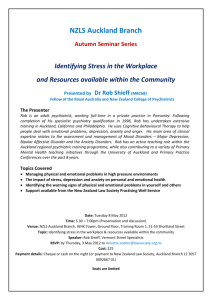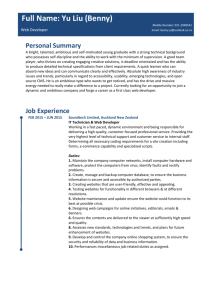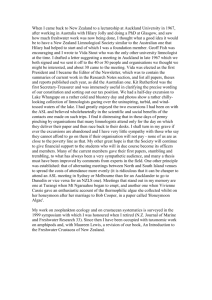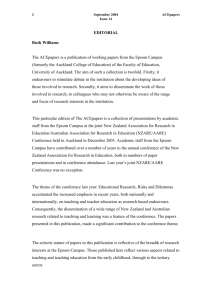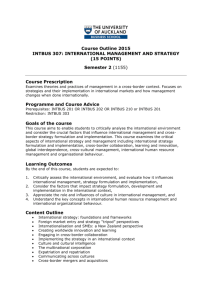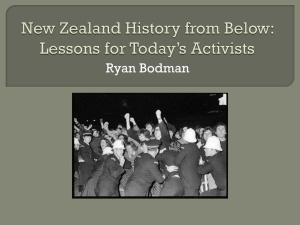An introduction to formative assessment
advertisement
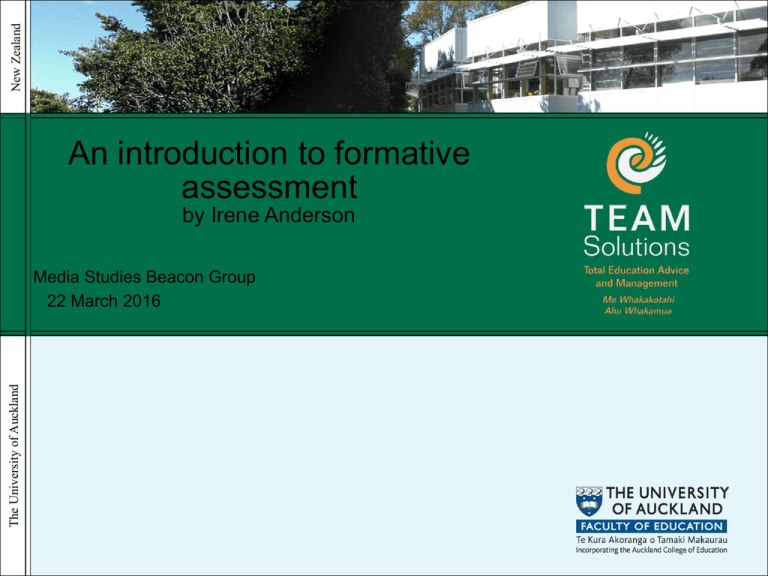
New Zealand An introduction to formative assessment by Irene Anderson The University of Auckland Media Studies Beacon Group 22 March 2016 The University of Auckland New Zealand 2005 What is formative assessment? If we think of students as plants… 2005 New Zealand The University of Auckland Summative assessment of the plants is the process of simply measuring them 2005 New Zealand The University of Auckland The measurements might be interesting to compare and analyse but in themselves they do not affect the growth of the plants. 2005 Formative assessment, on the The University of Auckland New Zealand other hand, is the garden equivalent of feeding and watering the plants - directly affecting their growth. The University of Auckland New Zealand 2005 Cowie and Bell, 1999 Formative assessment is the process used by teachers and children to recognize and respond to pupil learning, in order to enhance that learning during the activity or task. The University of Auckland New Zealand 2005 Black & Wiliam (1999) The research indicates that improving learning through assessment depends on 5 deceptively simple key factors: The University of Auckland New Zealand 2005 Number 1 The provision of effective feedback to students The University of Auckland New Zealand 2005 Number 2 The active involvement of students in their own learning The University of Auckland New Zealand 2005 Number 3 Adjusting teaching to take account of the results of assessment The University of Auckland New Zealand 2005 Number 4 A recognition of the profound influence assessment has on the motivation and selfesteem of students, both of which are crucial influences on learning The University of Auckland New Zealand 2005 Number 5 The need for students to be able to assess themselves and understand how to improve The University of Auckland New Zealand 2005 Formative assessment strategies include the use of Learning Intentions Or Learning Outcomes The University of Auckland New Zealand 2005 Formative assessment strategies include the use of Success CriteriaFormative assessment strategies include the use of The University of Auckland New Zealand 2005 Formative assessment strategies include the use of Quality Questioning The University of Auckland New Zealand 2005 Formative assessment strategies include the use of Quality learning conversations 2005 Formative assessment strategies include the use of The University of Auckland New Zealand Feedback and Feed forward 2005 Formative assessment strategies include the use of The University of Auckland New Zealand Self and peer assessment The University of Auckland New Zealand 2005 Why Use Learning Intentions? “Many pupils do not have a picture (of the targets their learning is meant to attain) and appear to have become accustomed to receiving classroom teaching as an arbitrary sequence of exercises with no overarching rationale… When pupils do acquire such overview, they then become more committed and more effective as learners: their own assessments become an object of discussion with their teachers and with one another…” Black & Wiliam 2005 Learning Intentions All these terms mean the same thing: New Zealand Learning intentions Learning outcomes The University of Auckland Learning objectives 2005 Learning Intentions What are we going to learn? The University of Auckland New Zealand They may be written like this: We are learning to … To be able to … To understand / explain / discuss etc Today we will be able to … New Zealand 2005 Getting learning intentions right Muddled learning intentions lead to: Mismatched activities Inappropriate focus Awkward success criteria Examples: The University of Auckland To understand how camera angles help to create suspense in film NOT To understand how camera angles help to create suspense in The Matrix Success Criteria 2005 How do we know we have met the learning intention? The University of Auckland New Zealand When success criteria are used … the learning becomes more explicit students can confirm, consolidate and integrate new knowledge future learning is scaffolded students can see what quality looks like Ann Davies What does success criteria look like? The University of Auckland New Zealand 2005 Learning Intention: To understand how camera angles help to create suspense in film Success Criteria: I can: Give an example of how camera angles are used to create suspense Comment on the effect of the example described Support my comments with reasons and/or justify them Analyse the use of camera shots by discussing their use in the film as a whole or other films The University of Auckland New Zealand 2005 What does research tell us about feedback? Hattie’s meta analysis of influences on student achievement showed: Average effect was .40 Feedback was .79 Only direct instruction and reciprocal teaching were higher Students’ prior cognitive ability followed feedback What is effective feedback? The University of Auckland New Zealand 2005 It should be: about the work, not the student Comments, not grades or marks aimed at closing the gap between where the student is now and where he/she should be to achieve the standard short The University of Auckland New Zealand 2005 An example of feedback To gain Merit you need to develop the effect of the low angle shot with more specific detail. To gain excellence you need to consider how low angle shots are used elsewhere in the film or commonly used in other films of this genre. and improvement marking strategy The University of Auckland New Zealand 2005 Further Reading Absolum, Michael. (2006) Clarity in the Classroom, Using Formative Assessment Hodder Education Clarke, Shirley. (2005) Formative Assessment in the Secondary Classroom Hodder Education Hawk, K. & Hill, J. (2001) The Challenge of Formative Assessment in Secondary Classrooms SPANZ Journal, September 2001.


